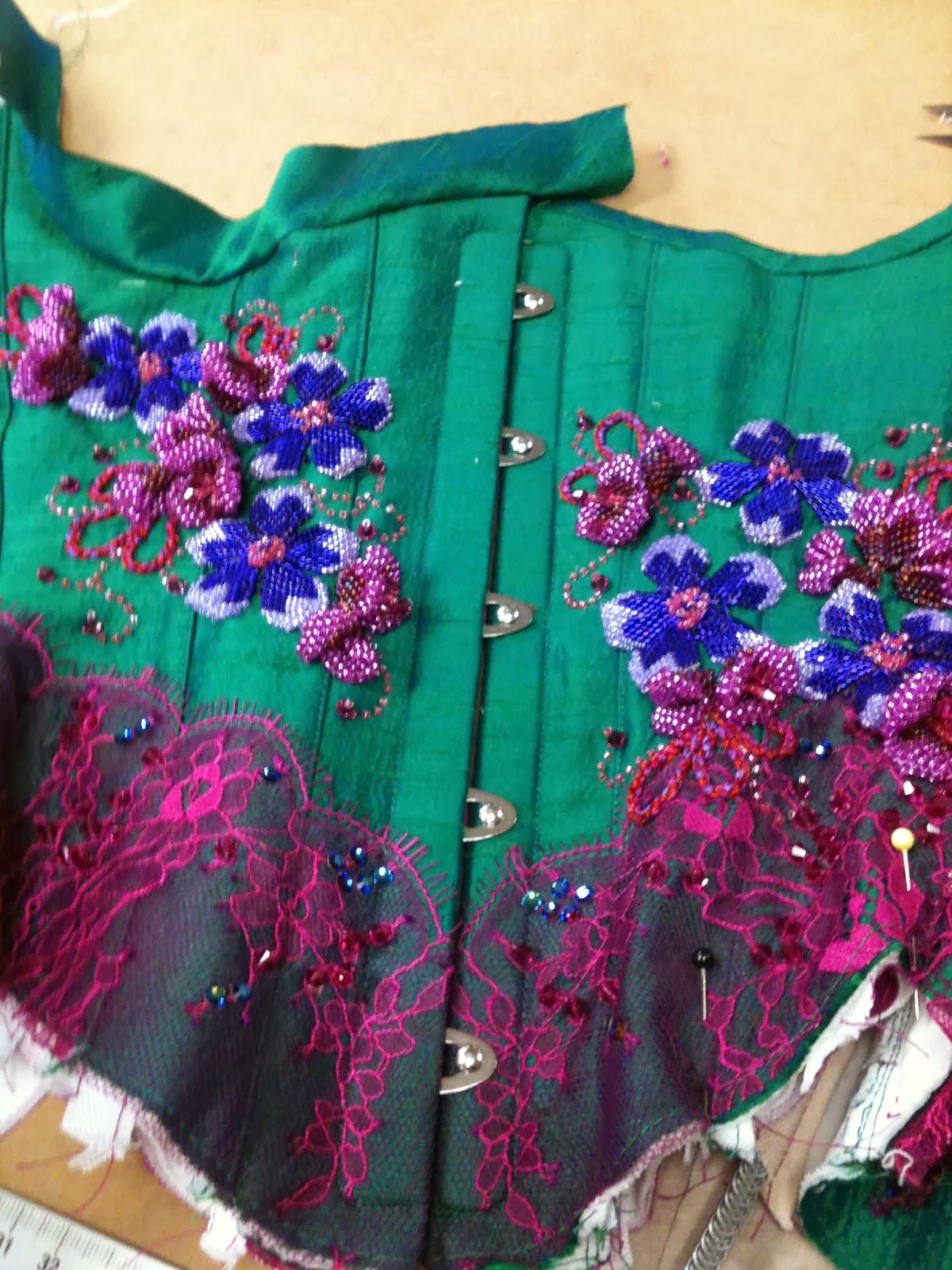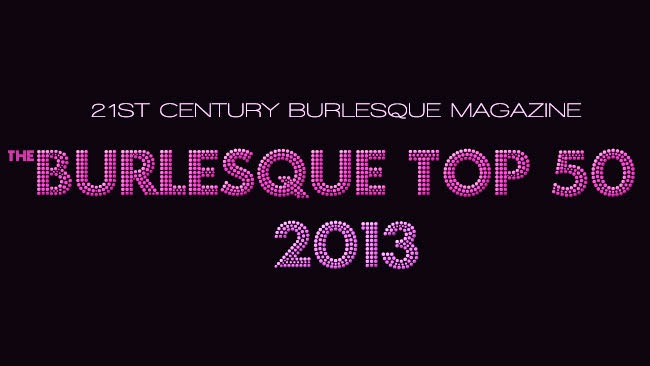This article was first published on the amazing corset-making website www.foundationsrevealed.com in 2012. Thank you to the lovely team at FR for allowing me to re-post the article in full here!
Drafting a lace overlay for an underbust corset
As a costumier
working in a particular niche area, there's nothing I enjoy more than
combining a lovely curvy corset with delicate lace and sparkling
embellishments.
To me, there's
nothing more satisfying than holding a shimmering costume piece under
various lights and enjoying the reflection of hundreds of Swarovski
crystals and beads...
 |
| Orange corset with black lace by Flo Foxworthy |
For this article we'll be drafting a
simple border lace overlay for the top half of an underbust corset
(pictured here in Orange silk with black lace). We'll be using a
technique called pattern manipulation, if you've done much pattern
drafting for regular clothing then you've probably used this
technique to manipulate darts.
If you've never drafted anything then
don't worry – it's not complicated and once you get the hang of it
you'll be able to try all sorts of new design ideas!
This method can be used to create a
lace (or any other fabric you care to try) overlay that is shaped to
fit your corset exactly, creating the perfect base for some serious
embellishment.
The same technique can also be used to
draft a pattern for the lower edge of a corset (see corset in Emerald
silk with fuchsia lace). Just follow the instructions below, but
trace the lower half of the pattern instead of the top half.
 |
| Emerald corset with fuchsia lace & beaded flowers |
There are already many excellent
articles on Foundations Revealed that discuss the various methods for
constructing your corset, so this article won't cover any of those
details.
For the purposes of this article, i'll
assume you have already constructed the outer shell of your corset
(or you have constructed your single layer corset), and are ready to
attach the lace overlay.
Tools required:
A finished pattern
It's best to use a pattern that has
already been fitted and that you are comfortable using. This can be
a pattern you've drafted yourself or one you've purchased, all that
matters is that you are happy with the fit and are ready to take the
design a step further.
I will be using a pattern I drafted as
an example, but if you're using a purchased pattern then I suggest
you lay it out on a smooth flat surface (your dining room table will
do nicely if you don't have the luxury of a dedicated work space) and
weight it down securely so it won't shift during the tracing process.
Tracing paper
I use a heavy weight tracing paper
known as Vellum (available at most art supply stores), it's used by
architects and is fantastic for patterns like this. It is
translucent to allow for easy tracing and sturdy enough to stand up
to repeated use as a finished pattern piece.
There are a variety of materials you
could use instead; waxed paper/freezer paper from the kitchen,
light-weight tracing paper, clear plastic sheets etc.
Mechanical pencil
When drafting patterns it's always a
good idea to use the finest pencil you can, to allow for greater
accuracy. Mechanical pencils are ideal for this purpose as they're
always sharp and create a fine even line.
If you're tracing on to plastic sheet,
then use a fine tip marker pen – Sharpies are available in a 0.4mm
tip.
A ruler and a curve
It's preferable to use a ruler and a
curve to maintain accuracy (but if you're more comfortable tracing
free-hand then I won't tell you off).
It's also helpful to have a grading
ruler on hand if your pattern has a seam allowance included, as a
fast way to draw in your stitching line. If you don't have a grading
ruler, then you can just measure the seam allowance with a regular
ruler.
 |
| Lace border |
Choosing your lace
It's great if you have the piece of
lace you'll be using in front of you at this stage, so you can play
with the lace and use it to it's best effect;
For example, if it's a floral lace, pay
particular attention to the leaves and petals and position the lace
so they flatter the lines of your corset.
Does your lace have a mirrored design
or does the design all go in one direction?
Does the lace have a definite right and
wrong side or can you flip it and use the reverse without it being
obvious?
If your lace has a mirrored design or
you can get away with flipping it and using the reverse, then you can
create a perfectly mirrored overlay that is the same on the left and
right sides of your corset.
If your lace can only be used on one
side (e.g. corded lace) and the design only goes in one direction,
then take a little time to plan out what part of the lace you'll use
on the left and right sides – you want the design to look balanced,
even if it's not identical.
Drafting the pattern
To begin, decide where on your corset
you'll be placing the overlay; For this example we'll be placing it
on an angle at the front of the corset, extending up to the side.
We'll start at the centre front and go
through each piece one at a time till we get to the centre back.
Please note: My original pattern does
not have any seam allowances added, so I can just trace the lines as
they are.
If your pattern DOES have seam
allowances included, then take a few minutes to draw in the stitching
lines (this is where a grading ruler comes in handy). When drafting
patterns it's much easier to do it without the seam allowances
included.
Trace around the 1st pattern piece (front), marking the waist line accurately.
 |
| Decide where you'd like the overlay to be placed, and draw it on to the pattern. In my example I started at the 3rd busk loop and angled up towards the back |
 |
This is where the tracing paper comes in doubly handy – you can now lay your new pattern piece on top of the lace and mark in the shape of the edge and any design features that will help you with the placement, such as seam lines and bone channel positions. Doing this will make it easier to ensure that your placement is perfectly even on both sides of the corset when the lace is attached.
Cut out your new pattern piece – you don't need to add any seam allowances as they've all been eliminated in the manipulation process.
Trace the pattern piece onto your
lace. You will have already planned what part of the lace you'll be
using for each side, so carefully trace and cut each piece as
accurately as possible.
Mark any important details such as bone placement lines etc using a fine chalk wheel or thread tracing.
Now it's time to attach the lace to the corset! As mentioned at the start of this article, we're jumping right in and assuming you have already constructed the shell of your corset so carefully place your lace pieces on the corset making sure to line up your placement lines so the pieces are positioned equally on the left and right sides. Use a ruler if necessary, checking that the lace details are balanced.
 |
Pin the lace in place and carefully stitch along the border edge to secure it to the outer layer of corset fabric.
|
If you're hand-stitching, use tiny stitches
so they aren't obvious, and if you've already inserted your busk and
attached your lining then slide your hand between the corset layers
to ensure you don't stitch right through to the lining.
 |
| Beading the corset before finishing the binding |
If you plan to bead the lace, do the majority of the work now - although don't attach beads right up to the edge until after binding, leave those areas till last or you'll just end up breaking something under the machine foot!
Note: You are welcome to machine-stitch the lace to the corset if you like, but I think it's more elegant and effective to use invisible hand stitches – it's all down to personal taste.
You are now ready to continue constructing your corset and bind the top edge - if you're using external casings over the lace then apply them now.
Once your corset has been bound
and had eyelets inserted, you can now finish any beading around the
edge of the corset... and if you have plans for further
embellishment then the fun starts now!
Embellishing your corset
 |
| Swarovski beads & rhinestones on a burlesque corset by Flo Foxworthy |
As I mentioned earlier in the article,
heavy beading should ideally be done before the binding is attached,
this makes it easier to stitch through the fabric – it can be
somewhat difficult (but not impossible) to stitch large areas of
beading to a finished corset.
When beading a corset, use a strong
synthetic fibre that won't fray against the edges of the beads. I
like to back-stitch two or three times through each bead to make sure it's secure
and won't snag easily on other garments.
When planning the embellishment for
your corset, look carefully at the design on the lace and consider
the effect you'd like to achieve. Do you want a delicate, feminine
look or a bold colourful statement piece?
 |
| Lace and Swarovski crystal rhinestones on a red burlesque corset |
It's fun to use a variety of colours
and textures in your embellishment to add depth and interest to the
garment. Pick out the details of the lace using flat-back
rhinestones on spots, bugle beads on leaves, and groups of round
beads on petals.. Try using unusual embellishments such as shells,
mirrors or tiny silk flowers and be adventurous with your choice of
colour!
Even a simple muted colour scheme can
be enhanced using beads in two or three similar shades.
Embellishments don't need to be sparkly – maybe pearls or frosted
glass beads are more suited to your style. It all adds to the
texture of a beautiful and unique garment.
The options are endless, and only
limited to your imagination. Have fun creating something completely
unique!
 |
| Fairy corset by Flo Foxworthy |
























